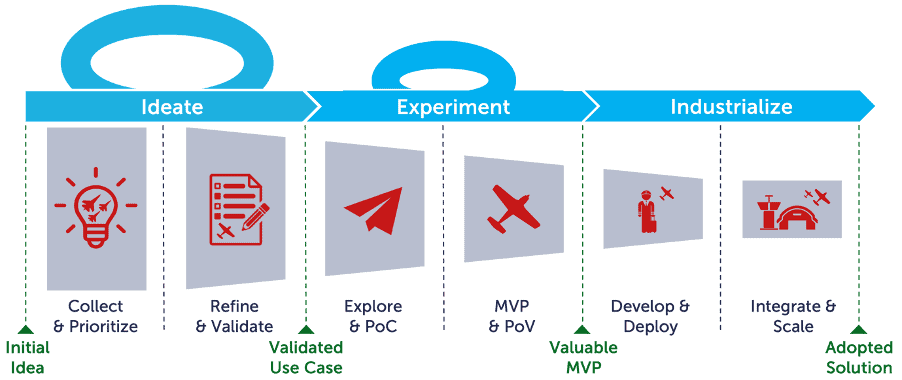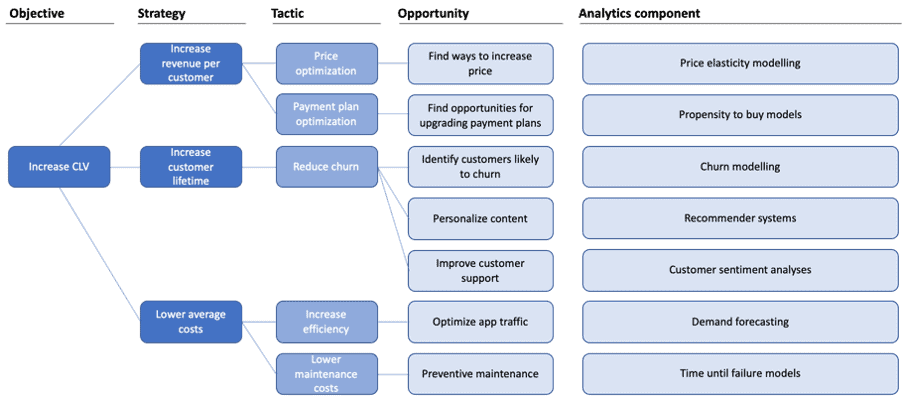[latexpage]
Data Science, Machine Learning and AI are means to an end, and therefore are not the beginning nor the end. Getting to succes requires an iterative process that takes you from an initial idea all the way to a solution adopted by the business. So where does this journey start? At ideation. A task often lead by an Analytics Translator or Product Owner.
In this blog, I’ll explain what the ideation phase entails, and how you can find valuable use case ideas yourself. To do so I will introduce you to the AI Solution Framework and two useful tools: opportunity trees and the experimentation canvas
The AI Solution Framework – Your roadmap for building an AI solution from start to finish
At GoDataDriven, we often use the AI solution framework to structure and execute data science projects. An overview of the framework is shown in the figure below. Next we will dive a bit deeper into the three main phases: ideation, experimentation and industrialization.

In the ideation phase we answer the question: “What is the best idea to develop into an AI solution?”. This question is answered by collecting ideas and refining them into validated use cases for which (potential) impact and feasilbity has been assessed. Only the most promising ones make it to the next phase: experimentation.
During the experimentation phase we turn to the next question: “Does the AI solution actually work in practice?” We develop our validated use case into a “minimum viable product” (MVP). This allows validation of the idea in-practice by testing the initial solution with actual end-users. Only once the MVP is deemed valuable, we move on to the final phase: industrialization.
During the industrialization phase we answer the final question: “How can the AI solution become part of the new business-as-usual?”. In this phase, the solution is finalized and deployed into production by driving end-user adoption while scaling the solution throughout the organization.
The AI Solution framework helps you remain focused on the finish line: build a solution that delivers actual value to the business and its customers.
The Ideation phase explored
Now that you have got a high-level overview of the process, we will go back to the subject of this blog; the ideation phase. Our aim is to create a short list of well defined, high-value, and feasible use cases for AI solutions.
There are many ways to do ideation. In this blog, I will outline an approach that has been working for me: opportunity finding. This method is actually nothing new, for example, check-out the following books for reference: “The minto Pyramid Principle” and “The mckinsey mind”. Here, I will tailor the method to the Data Science profession. You wil learn about the approach itself and I will provide you with some insightful examples.
Translate organizational goals into objectives
AI implementations are most successful when business goals are in line with the strategy and objectives of the organization. This brings me to your first challenge; translating your organizational goals into concrete objectives. The best starting point to determine the important KPI’s is to sit down with the people that are responsible for a set of KPI’s. This is often a great starting point to start the opportunity finding.
Some examples of potential objectives are:
- Increase revenue with 10% by the end of 2025
- Increase the user base of app A with 10% by the end of 2025
- Increase the Customer Lifetime Value with 10% by the end of 2025
When capturing and defining these objectives make sure they are:
- In line with strategy
- Quantifiable
- Time bound
- Divisible in mutually exclusive (non-overlapping) components
To give you an example of the mutually exclusive division of the first objective to “Increase – revenue with 10% by the end of 2025”:
- Increase number of customers
- Increase revenue per customer
- Reduce customer churn
Now, lets look at how we can can start applying opportunity trees to these collected objectives and continue our opportunity finding conquest.
Opportunities trees for idea generation
The business objectives dicussed in the previous section can serve as root of a logic tree, they form basis of the opportunity finding approach. From there you can start branching the tree, until it is completely mutually exclusive and completely exhaustive (MECE). This means you have broken up the tree until you can no longer make any logic splits, and all logical branches have been created. At this stage, you have successfully created your opportunity tree. Find a minimal example below:

Let me elaborate by an example based on Netflix, a company that provides a payed video streaming service that allows people to consume high quality content, without ads.
A practical example – Increase CLV at Netflix
As Netflix is a subscription-based company, the period that a customer is a client is a very important factor in the value of the company. We will therefore assume that their most important KPI’s will be the Customer Equity (CE) and the Customer Lifetime Value (CLV). The CE is a proxy for the future value of your total customer base, the CLV is a proxy for the future value of a single customer. For those unfamiliar with these concepts please check out this Wikipedia page, this will help you understand the examples below.
Let’s assume that we got to these KPI’s from discussions with higher management. Your next moves should then be as follows:
- Create a mutually exclusive and completely exhaustive logic tree
- Figure out what diverse group of people could generate ideas on how to improve the KPI’s
- Set up a 2-hour workshop with the identified group of people. During this session, you will:
- Explain the tree
- Explain the assignment to write down ideas that will improve the KPI for each branch of the tree:
- Discuss the end result, and try to get an idea what the most promising solution directions are.
Let me also provide you with some tips for facilitating the 2-hour workshop:
- Ideas must fit on a post-it;
- Ideas must be understandable from the post-it;
- Ideas must have the initials of the ideation on them, so you can get back to them later;
- Avoid discussions at all costs: facilitate silence, this will vastly increase the number of penned down ideas.;
- While others write, collect and group similar ideas on a wall to discover common topics.
Overall, working with opportunities to further develop opportunities has a couple advantages:
- You start with objectives that are relevant to your sponsors, this guarantees management buy-in.
- You can be quite sure that you have covered all angles of solving the problem.
- Because of the structure, it will be easier to quantify and compare ideas, this will help prioritizing.
- By involving colleagues at the start, they will be more committed to help developing the solution, and eventually adopting it.
The figure below shows the opportunity tree that could have resulted from this effort ( I admit it is not completely exhaustive, but it serves the purpose of explanation).

Great, we have now collected a large set of solution directions. However, we still have to prioritize all of these possible directions. I’ll give an example on how to do this by working out one of the ideas: “Build content recommender systems”.
Validating the business case
In validating the business case we start from considering the business assumptions which the idea direction builds upon:
- The higher the customer loyalty, the higher the customer lifetime value
- The more content a customer consumes, the higher the loyalty
- The better our content recommendation, the more content a customer consumes
So, if this is true, what would be the theoretical value of this solution?
For this example, I will compute them as follows:
$ CLV = ( average,revenue,-,average,costs ) times lifetime times discount,value $
$ discount,value = ( 1 + discount,rate )^{-lifetime} $
$ lifetime =frac{1}{churn} $
A more detailed explanation on CLV can be found on wikipedia
I’ll make a set of assumptions about the company’s statistics to do the calculations:
- Number of customers (as-is) = 150 million
- Average revenue (as-is) = 10∗12 months
- Average costs (as-is )= 8∗12 months
- Churn (as-is) = 4% per year
- Churn (recommender) = 3% per year
- Discount rate = 3% per year
When we fill in these figures into the formulas that we saw before we will get to a back of the envelope valuation of 1.81 billion!
$CLV_{as-is}=(10-8)times 12 times frac{1}{0.04} times (1+0.04)^{-frac{1}{0.04}}=286.56$
$CLV_{recommender} = (10 -8) times 12 times frac{1}{0.03} times (1+0.03)^{-frac{1}{0.03} }=298.66$
$Estimated,value = (298.66 – 286.56) times 150 million = 1.81 billion$
So, if the numbers are correct, and our solution indeed reduces churn from 4% to 3%, it would be a huge business case. Our biggest assumptions however, is the relationship between the recommendations and churn, as well as the relationship between churn, and the average time a person will remain a customer. Those would need to be validated during an experiment to determine the real value of the idea.
If you repeat this exercise for the ideas that you think have the highest potential value. You will quickly have a quantified list of ideas, and a list of hypothesis that require validation. Remember though that prioritizing should involve a brief feasibility study too where you assess organizational, technical, and data feasibility.
Conclusion
You don’t have to be a techie to become successful in the field of AI. Techies are great at building AI solutions, but you need people that really understand the business to figure out where to invest their time in. It is time for you to step in and put on the Analytics Translator hat, and in this blog, I’ve provided you with a tool to make a start.
Are you interested in learning more?
Do you want to know more about AI strategy? Check out this blog!
Or about the Analytics Translator role? Check out our whitepaper!
Or about the Data Science for Product Owners learning journey? Check out the learning journey!




